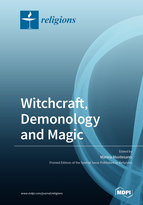Witchcraft, Demonology and Magic
A special issue of Religions (ISSN 2077-1444).
Deadline for manuscript submissions: closed (15 April 2019) | Viewed by 96998
Special Issue Editor
Interests: cultural history; medieval history; magic and witchcraft in medieval and renaissance culture; preaching in the late middle ages; crossdressing
Special Issue Information
Dear Colleagues,
Witchcraft and magic are topics of enduring interest for many reasons. The main one lies in their extraordinary interdisciplinarity: anthropologists, folklorists, historians, and more, have contributed to build a body of work of extreme variety and consistence. Of course, this also means that the subjects themselves are not easy to assess. In a very general way, we can define witchcraft as a supernatural mean to cause harm, death or misfortune, while magic also belongs to the field of supernatural, or at least esoteric knowledge, but can be used to less dangerous effects: like for divination and astrology. In the Western civilization, the witch-hunt of the late medieval–early modern times has set a very peculiar perspective in which diabolical witchcraft, the invention of the Sabbat, the persecution of many thousands of people, gave way to a phenomenon that is fundamentally different from traditional witchcraft; even if in many case studies in South America or Africa may present similarities, especially in contemporary times (see Nathan Wachtel, Dieux et Vampires – Retour à Chipaya, 1992, and Peter Geschiere, The Modernity of Witchcraft: Politics and the Occult in Postcolonial Africa, 1997). Another peculiarity of magic and witchcraft in Western civilization is given by the number of writings that detailed their nature, techniques, effects: they could be technical treatises about how to perform magic, like in the case of necromancy (see Richard Kieckhefer, Forbidden Rites. A Necromancer’s Manual of the Fifteenth Century, 1998, and Florence Gal, Jean-Patrice Boudet, Laurence Moulinier-Brogi, Vedrai mirabilia. Un libro di magia del Quattrocento, 2017); moreover, we know many writings explaining the powers of witches from the point of view of judges and inquisitors.
Also, nowadays scholars generally agree on the so-called ‘cumulative concept of Western witchcraft’, meaning that, if there is one thing that recent scholarship about witch-hunting has assured us of, it is that all mono-causality theories must be ruled-out, as so many factors have been discovered and investigated: the climate change which occurred around the year 1600 and its socio-economic fall-out (Wolfgang Behringer, Witchcraft Persecutions in Bavaria: Popular Magic, Religious Zealotry and Reason of State in Early Modern Europe 1997, and Id., A Cultural History of Climate, 2009); the scientific debates that framed many of the phenomena related to witchcraft (Stuart Clark, Thinking with demons: the idea of witchcraft in early modern Europe, 1997); the social conditions in village communities and how often bottom-up pressures gave way to trials against alleged witches (Robin Briggs, Witches and Neighbors: The Social and Cultural Context of European Witchcraft, 2002); the reading of folk-beliefs in light of heretical prosecutions and demonology (Richard Kieckhefer, European Witch Trials: Their Foundations in Popular and Learned Culture, 1300-1500, 1976); the role of humanistic culture in the developing of the witch-hunts (Marina Montesano, Classical Culture and Witchcraft in Medieval and Renaissance Italy, 2018). All of these, and many other approaches, have proven very useful for understanding the witch-hunts, but only as pieces of a puzzle.
In Western societies, the interaction between magic/witchcraft and religion is constant: even if the trials were held, as often happened, by secular judges, theology and demonology as it had been built between the Middle Ages and the Renaissance was central. However, apart from this general consideration, there are many fields in which popular religion (meaning the set of uses widespread in societies) and institutional religion interacted with magic and witchcraft, like for the role of monks and priests in performing occult sciences and ritual magic; religious images and elements (such as the sacramental bread) in witchcraft and magic rituals; ceremonial magic and Sabbat as an inversion of Catholic rituals. Aim of this special issue of Religions is to investigate different topics of these fields in medieval and modern European societies.
Prof. Dr. Marina Montesano
Guest Editor
Manuscript Submission Information
Manuscripts should be submitted online at www.mdpi.com by registering and logging in to this website. Once you are registered, click here to go to the submission form. Manuscripts can be submitted until the deadline. All submissions that pass pre-check are peer-reviewed. Accepted papers will be published continuously in the journal (as soon as accepted) and will be listed together on the special issue website. Research articles, review articles as well as short communications are invited. For planned papers, a title and short abstract (about 100 words) can be sent to the Editorial Office for announcement on this website.
Submitted manuscripts should not have been published previously, nor be under consideration for publication elsewhere (except conference proceedings papers). All manuscripts are thoroughly refereed through a double-blind peer-review process. A guide for authors and other relevant information for submission of manuscripts is available on the Instructions for Authors page. Religions is an international peer-reviewed open access monthly journal published by MDPI.
Please visit the Instructions for Authors page before submitting a manuscript. The Article Processing Charge (APC) for publication in this open access journal is 1800 CHF (Swiss Francs). Submitted papers should be well formatted and use good English. Authors may use MDPI's English editing service prior to publication or during author revisions.
Keywords
- Witchcraft
- Magic
- Circulation of Knowledge
- Popular
- Institutional Religion






